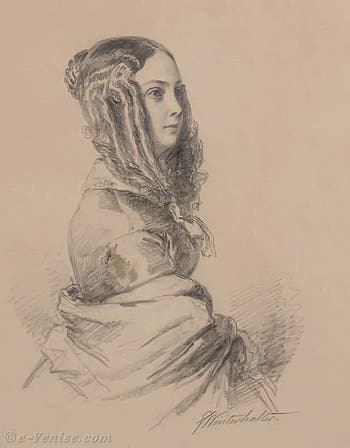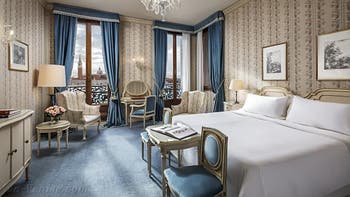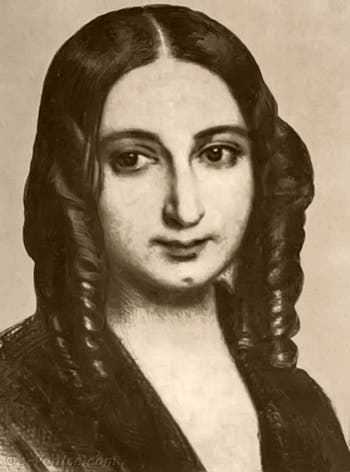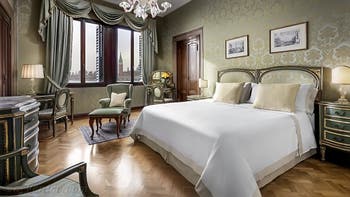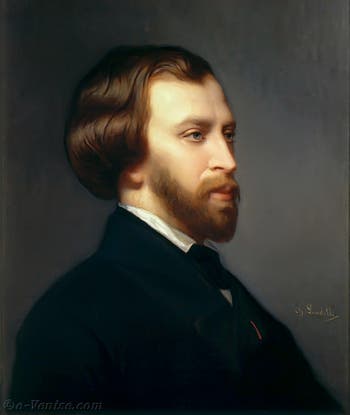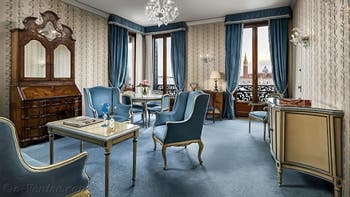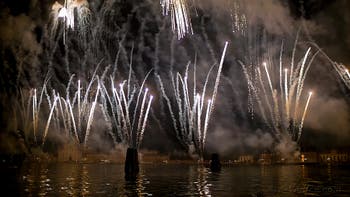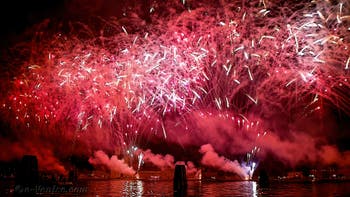Art Painters | Music | Literature | Video | Pictures
Literature Byron | Baffo | Erasmus | Gautier | Goldoni | Mérat | Montaigne | Musset | Régnier | Rilke | Sand | Schopenhauer
George Sand and Alfred de Musset's room at the Hotel Danieli
The two famous lovers arrived at the Hotel Danieli on 31 December 1833 and stayed there until 13 March 1834, when they moved to Calle delle Rasse, just behind the hotel, into a furnished apartment.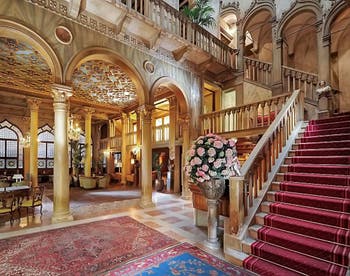
The Hotel Danieli in Venice We are fortunate to have an interesting and very moving account of the room occupied by the romantic couple at the Hotel Danieli.
Now smaller, George Sand's room has been divided in two, with the other part becoming the manager's office.
This account is all the more captivating as it also features Monsieur Danieli himself, the son of the first owner of the Hotel Danieli, talking about Alfred de Musset, the doctor Pagello and Honoré de Balzac.
The author of this account is Louise Colet, who had an affair with Alfred de Musset.
At the time she stayed at the Hotel Danieli, Alfred de Musset had been dead for two years.

The Danieli Hotel in Venice During the night, she had a dream in which her deceased lover, Alfred de Musset, appeared to her. Day broke, and this is her account:
“Around noon, while my room was being prepared, I went to chat with the hotel owner's daughter, a sweet and cordial person who enjoyed talking to me about France.
I found her father, the old and intelligent Danieli, standing near her.
Louise Colet Pursued by the voice of my dream, I suddenly said to him:
“You who know Venice so well, you must know where the Nani palace is located?”
“The Nani palace?” he replied in surprise. “But, madam, you are there.”
“No! Your palace is called the Bernardo palace!”
“Bernardo Nani” replied the innkeeper, “it belonged twenty-five years ago to Count Nani-Mocenigo, who gave it his name; I acquired it after the count's death, and it then resumed its old name, the Bernardo palace.”
“In that case,” I replied eagerly, “you knew Alfred de Musset, he stayed here?”
“Alfred de Musset?” repeated Mr. Danieli, as if trying to remember.
“Yes,” I replied, “a French poet.”
“What is certain,” continued Mr. Danieli, “is that I had one of your famous authors, Mr. de Balzac, staying at my house; he even gave me one of his novels.
But the other one, I can't remember his name...”
“Remember, Mr. Danieli! He was a young blond man!”
The Hotel Danieli in Venice “Oh! Yes,” cried the hotelier, “a young blond man who was ill at my hotel, very ill. But please wait a moment, I will give you a definite answer.”
Mr. Danieli left, leaving my curiosity hanging in the air; he reappeared almost immediately, holding a huge register in his hands.
“Look in the year 1834,” I said, “or at the end of 1833.”
Mr. Danieli turned a few pages: “Here it is,” he said, pointing to a signature that made me start.
George Sand I read:
“ALFRED DE MUSSET, Paris, 7 December 1833.”
“Oh!! I remember now,” said the innkeeper, rereading the name and another that preceded it. “That handsome young blond man was seriously ill here. The old doctor Santini treated him.”
“An old doctor, you say?”
“Always accompanied by an assistant, a young student who performed bloodletting and administered purgatives, as was the custom in Venice at the time,” replied Mr. Danieli.
“Since then, Santini's student, the good Pietro Pagello, has become a doctor himself; I can tell you this with certainty, for I am the godfather of his eldest daughter, who was married this year in Treviso.
That devil Pagello had eight children, by his two wives!
He practises in Bellune, where people come from all over the surrounding area to consult him, and he would be very happy if he had not fallen completely deaf; he cannot even hear with a horn: people have to write to him to ask him something, and he replies in the same way.
The Danieli Hotel in Venice Our dear Pagello was not always such a renowned doctor; he had travelled to Paris, from where he returned very happy with a little money and a box of instruments for crushing stones (lithotripsy instruments).
He first performed a few disastrous operations, which discredited him in Venice, but he took his revenge in Belluno and throughout the Italian Tyrol.”
I was not particularly interested in the biography of this poor doctor who had gone deaf, but I listened without interrupting Mr. Danieli, who seemed delighted to talk to me about his friend. When he had finished, I simply asked him:
“Was Pietro Pagello a handsome man?”
“A tall, blond fellow, a little stocky, with a Prussian appearance.”
“Let's get back to the other blond young man,” I said. “Does the apartment where he stayed still exist in your hotel?”
“If it exists! It's very close to your room...”
I couldn't help shivering.
“It's number 13,” continued Mr. Danieli, “at the end of the large gallery on the left.”
I got up immediately.
“Take me there,” I cried, “I want to see this apartment immediately.”
“Oh! That's easy, it's empty like all the others, alas!”
Alfred de Musset Mr. Danieli had a key brought to him and walked ahead of me.
We climbed the marble staircase decorated with busts, then crossed the great hall of honour of the Bernardo-Nani palace, which had been turned into a passageway.
We reached the end of the gallery, in front of the small wooden staircase that led to my room, which, as I have said, was set in rooms with high ceilings that had been divided to create two mezzanine floors.
We turned left, where there is an open banister that frames and crowns the vestibule.
We were in front of the door of number 13. Mr. Danieli opened it; we took three steps into a small passage, passed through a second door, and found ourselves in the room where Alfred de Musset had nearly died in Venice.
It connects to another room of about the same size, which leads to a large living room with two large windows opening onto the Quai des Esclavons.
The island of San Giorgio is opposite with its church and its bell tower, which seems to float on the lagoon; on the right rise the Dogana da Mar and the Salute; on the left, in the distance, behind the Quay of the Slaves, is the public garden grouped together on the waves like a gigantic bouquet of aquatic flowers.
The Hotel Danieli in Venice I lean for a moment against one of the windows, then, looking around the salon, I inquire about the changes that have been made to its layout and furnishings.
“The drawing room was larger in the days of the young blond gentleman,” said Mr. Danieli (who always referred to the author of Rolla in this way); “we cut part of it off to make a hallway.
At that time, it was hung with dark blue silk, just as it was when Mr. de Balzac stayed here two years later, for I remember the exact dates, thanks to my register," added the innkeeper.
Mr. Balzac also had the two rooms you have just seen, he continued, nothing has been changed in their layout; only the wallpaper and curtains have been replaced.”
We had returned to those two memorable rooms. I stopped in the one where Alfred de Musset had lived, and looked with emotion at the bed where he had suffered so much and at the tilted mirror where his pale and noble face had been reflected.
Mr. Danieli, surprised by my examination and my emotion, said to me:
“So Mr. de Balzac and that young blond man were very important figures in France?”
“Important enough,” I replied, smiling at his epithet, “that I advise you to replace the illuminations that decorate the large salon with their portraits and to inscribe the names of these glorious guests on the threshold of this apartment.”
“Do you think that will please travellers and attract them?” replied the innkeeper.
“Yes,” I replied; “many women will come here on pilgrimage ; in the meantime, will you leave me there for a few hours while the snow is falling and I cannot go out?”
“Very gladly,” replied Mr. Danieli ; and as he withdrew, he added: “It is a good idea ; I will write to my correspondent in Paris and ask him to send me these two portraits.”
When I was alone, I began to cry, overcome by that anguish of human powerlessness which constantly evokes but cannot revive what is no longer there.
I went from his room to the other room, then to the living room; I touched the walls, leaned against the windows, it seemed to me that the furniture was moving, that he was there, ready to appear to me alive, young, handsome, inspired; hadn't I heard his voice the night before, why then would the miracle not be complete?
The snow continued to fall from the darker sky; not a voice was heard outside, not a gondola cut through the lagoon; Venice around me seemed dead; I myself was seized with vertigo... ; a funeral chill came over me, “Death makes one see death,” I thought, “if I died here, I would see him again... we would speak to each other with the gentleness of ghosts... it would be good and sweet after so many storms.”
I sat down in an armchair in his room and remained there for a long time, thinking thus.
I was torn from my happy hallucination by the announcement that a visitor was waiting for me.
I found Baron Mulazzani in my room; he had arrived through the snow with the help of his riding boots.
“I thought you were dying of boredom in this Greenland weather,” he said, “and that a little company would not displease you.”
“The great discovery has been made,” I replied, “and this has been the most interesting day I have spent in Venice.”
“Are you a romantic?” he asked me when he found out what it was about. “Are you young?”
“Dear Baron,” I replied, “I am actually older than you, but the soul that knows how to admire and love remains intact when the body decays.”
He gently teased me about what he called my spiritualism, and ended up telling me some Venetian anecdotes.
Louise Colet - L'Italie des Italiens 1862
George Sand and the Corte Minelli in Venice
The Corte Minelli, very close to the Fenice Opera House, was included by George Sand, who lived next door, in her novel Consuelo: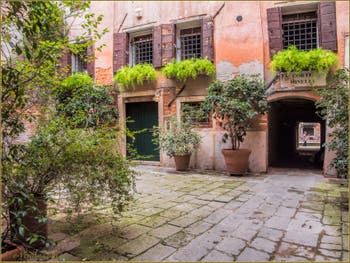
La Corte Minelli, described by George Sand
“It was in the Corte Minelli, near the church of San Fantin, that Anzoleto found himself at the moment when the clocks struck two o'clock after midnight.
A secret instinct had led him to the home of a person whose name and image had not crossed his mind since sunset.
No sooner had he entered the courtyard than he heard a soft voice calling him by the last syllables of his name; and, raising his head, he saw a slight figure appear on one of the most miserable terraces within the enclosure.
A moment later, the door of this hovel opened, and Consuelo, dressed in an Indian skirt, and her bodice wrapped in an old black silk cloak that had once been her mother's finery, came forward and held out her hand to him, while with her other finger she touched his lips to bid him be silent.
They tiptoed and groped their way up the winding, dilapidated wooden staircase that led to the roof.
And when they were seated on the terrace, they began one of those long whispers interspersed with kisses that can be heard every night on the rooftops, like mysterious breezes or the babbling of air spirits flitting in pairs through the mist around the bizarre chimneys that crown all the houses of Venice with their numerous red turbans.”
George Sand — "Consuelo - The Countess of Rudolstadt"
The Night of the Redentore or the Notte Famosissima as seen by George Sand
“The island of Giudecca, where the Church of the Redeemer is located, being one of the richest parishes, offers one of the most beautiful festivals.
The Feast of the Redentore The gateway is decorated with a huge garland of flowers and fruit; a bridge of boats is built over the Giudecca Canal, which is almost a sea arm at this point.
The entire quay is covered with pastry shops, tents for coffee, and those field kitchens called frittole, where the kitchen boys bustle about like grotesque demons, amid the flames and swirls of smoke from boiling fat, whose acrid smell must take the breath away from those passing by at sea three leagues from the coast.
The Austrian government (which then occupied Venice) prohibited dancing in the open air, which would greatly detract from the merriment of the festival among any other people; fortunately, the Venetians have in their character an immense store of joy.
Their capital sin is gluttony, but a chatty and lively gluttony, which has nothing in common with the heavy digestion of the English and Germans ; The Muscat wines of Istria, at six sous a bottle, produce an expansive and facetious intoxication.
The Feast of the Redentore All these food shops are decorated with foliage, banners and coloured paper balloons that serve as lanterns; all the boats are decorated with them, and those of the wealthy are decorated with remarkable taste.
These paper lanterns take all shapes: here they are acorns falling in luminous festoons around a baldachin of colourful fabrics; there they are antique alabaster vases, arranged around a canopy of white muslin whose transparent curtains envelop the guests; for they are dining in these boats, and through the gauze one can see the silverware shining and the candles mingling with flowers and crystals.
A few young men dressed as women half-open the curtains and shout impertinent remarks at passers-by.
The Feast of the Redentore At the bow stands a large lantern shaped like a tripod, a dragon or an Etruscan vase, in which a gondolier, bizarrely dressed, throws powder that bursts into red flames and blue sparks.
All these boats, all these lights reflected in the water, jostling and racing in all directions along the illuminated shore, create a magical effect. […]
The closed gondola of the old nobleman, the splendid boat of the banker or merchant, and the rough boat of the vegetable seller, dine and glide together on the canal, bump into each other, push each other, and the orchestra of the rich mingles with the hoarse songs of the poor.
Sometimes the rich man silences his musicians to enjoy the risqué refrains of the boat; sometimes the boat falls silent and follows the gondola to listen to the rich man's music.”
George Sand, "Lettres d'un voyageur" (Letters of a Traveller) - 1834
Literature Byron | Baffo | Erasmus | Gautier | Goldoni | Mérat | Montaigne | Musset | Régnier | Rilke | Sand | Schopenhauer
Art Painters | Music | Literature | Video | Pictures
Back to Top of Page


